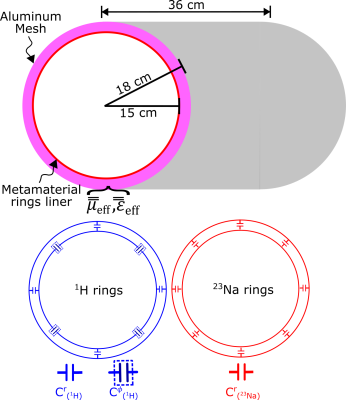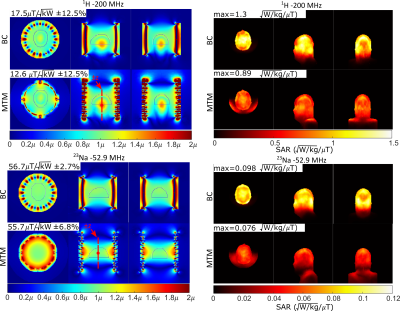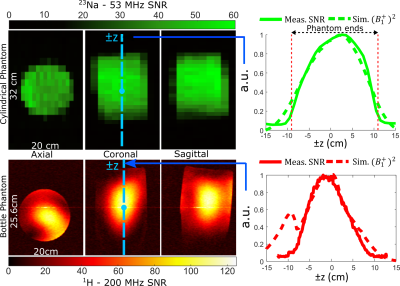2499
Metamaterial Liner RF Head Coil for 23Na and 1H at 4.7 T1Oncology, Medical Physics, Cross Cancer Institute, University of Alberta, Edmonton, AB, Canada, 2Electrical and Computer ENgineering, University of Alberta, Edmonton, AB, Canada
Synopsis
Well-established and emerging methods of 23Na sodium imaging in the brain benefit from high field strength, but require imaging sequences that are constrained by specific absorption rate (SAR) limits. Additionally, concurrent proton imaging is desirable for complementary anatomical/structural information. Here, we present a novel metamaterial liner-based MR coil for 23Na/1H imaging at 4.7 T, consisting of longitudinally-spaced rings that alter the effective electromagnetic properties between the liner and outer RF shield (waveguide boundary). In simulation, the metamaterial liner was found to produce lower local 10g averaged SAR for the same mean transmit field relative to a conventional birdcage coil.
Background
Increasing B0 field strength is desirable due to the increased SNR, especially for 23Na imaging, which has approximately 3000 times lower MR sensitivity relative to 1H in the body1. However, at high field strengths the use of high flip angles (FA) and short repetition time (TR) sequences (emerging methods of 23Na employing multi-pulse sequences2,3) is constrained by the local specific absorption rate (SAR).. We propose a novel transmit resonator consisting of a stack of longitudinally-spaced ring structures, previously explored for high frequency microwave applications (3.2GHz)4,5. This structure was subsequently described theoretically as producing an effective near zero radially-oriented permittivity in the annular region between the rings and a surrounding conductive shield. This engineered metamaterial property drastically lowers the cutoff frequency of the hybrid-electric (HE11, which resembles TE11) cylindrical waveguide mode, allowing propagation in the longitudinal direction similarly to travelling-wave MRI6. This structure distributes the electric fields more homogenously over the imaging subject compared to conventional resonators, thereby reducing SAR7,8.Purpose
To demonstrate a metamaterial liner for dual tuned 23Na/1H head imaging at 4.7 T that harnesses the improvement in SAR performance compared to a conventional birdcage coil.Methods
Individual rings of the metamaterial structure consist of radially-oriented capacitors separated by arc-shaped sections of conductor; azimuthally-oriented capacitors are included in series with the segments for the 1H tuned rings. The structure is similar to that of the annular ladder resonator9, but the metamaterial liner is a distributed structure that consists of many strongly-interacting, closely spaced rings (nine 23Na and nine 1H alternatingly tuned rings here) and is engineered using metamaterial methods. By theoretical analysis, the effective medium properties within the liner, as depicted in Figure 1, are represented as biaxial for the effective permittivity $$$\bar{\bar{ε_l}}=ε_0\bar{\bar{I}}(ε_r,ε_r,1)$$$ and uniaxial for the permeability $$$\bar{\bar{μ_l}}=μ_0\bar{\bar{I}}(1,1,μ_z)$$$, where $$$ε_r$$$ is negative and near zero and $$$μ_z$$$ is large and negative at the desired cut-off frequencies of the HE11 mode. Furthermore, the metamaterial liner dispersion must produce the HE11 mode with a λ/2 longitudinal resonance over its length. The capacitor values that produce the required metamaterial properties and resonance were found by simulation (Ansys, HFSS) of the propagation-dispersion characteristics of the structure with the eigenmode solver using the methods employed in Reference 4. The metamaterial liner was constructed by wrapping two ROGERS 3006TM laminates (0.25mm thick, ε=6.15, tan𝛿=0.025, 18 μm thick copper) with conductor layout shown in Figure 2 around a 1-mm-thick polycarbonate cylinder. Parallel plate capacitors were realized by etching overlapping pads, including isolated pads that could be joined by conductive bridges for fine tuning on the bench. The transmit efficiency ( $$$B_1^+$$$ ) for 1 kW input power and 10g average local SAR normalized for a mean 1µT field were calculated within the same region of the head for both the metamaterial liner and a single-tuned shielded hybrid birdcage coil. Models of birdcage coil and metamaterial liner, and constructed metamaterial resonator, are shown in Figure 3. The birdcage coil capacitor tuning values were Cring=282 pF, Cleg=150 pF for 23Na and Cring=16.58 pF, Cleg=8.2 pF for 1H. All conductors were modelled with a surface impedance boundary (5.8$$$×10^7$$$S/m) and the VHP female human body model 2.010,11,12 was used as a load. 23Na Imaging was carried out on a cylindrical phantom (20 cm height, 7 cm radius, 2.64g/L CuSO4·H2O and 5.59/L NaCl) with parameters: 3-plane, single 50mm thick slice, 2D gradient echo sequence, TR=400ms, TE=4.3 ms, 32x64 matrix, 32x32cm2, Navg=4, BW=8.043kHz. 1H imaging was carried out on a bottle phantom with parameters: 3-plane, five 4mm slices, 2D gradient echo sequence, TR=130ms, TE=7ms, 256x100 matrix, 25.6x20cm2, Navg=1, BW=34.965kHz. Low-power imaging with small FA was carried out for this preliminary test.Results
The mean transmit efficiency inside the outlined region displayed in Figure 4 is lower for the metamaterial liner compared to the birdcage coil (12.6 vs. 17.5$$$μT/\sqrt{kW}$$$ at 200MHz, and 55.7 vs. 56.7$$$μT/\sqrt{kW}$$$ at 52.9MHz), and more inhomogeneous at 52.9MHz (6.8% vs. 2.7%), but equally homogenous at 200MHz (both 12.5%). However, for a normalized mean 1µT excitation the simulated local 10g averaged SAR is 22% lower at the 23Na frequency for the metamaterial liner vs. birdcage coil (0.076 vs. 0.098 $$$\sqrt{W/kg}/μT$$$) and 32% lower at the 1H frequency (0.89 vs. 1.30 $$$\sqrt{W/kg}/μT$$$). Imaging performed with 1H and 23Na (Figure 5) demonstrates the prototype metamaterial liner functions as a volume coil. For the low FA imaging employed SNR~$$$∝(B_1^+ )^2$$$, and thus the simulated $$$ (B_1^+ )^2$$$ and measured SNR along the z-axis shown in Figure 5 are in close agreement.Discussion
The metamaterial liner represents a new class of volume transmit coil with desirable features and many potential design variations. The benefit of the metamaterial liner in this implementation was a more distributed current pattern with the metamaterial liner resulting in a 22% lower maximum local SAR for 23Na and 32% lower for 1H. Lower SAR is critical for high field 23Na imaging to comply with regulatory limits while ensuring efficient scanning and avoiding lengthening the repetition time or reducing the number of acquired slices13. Future work will focus on detailed validation of the simulated SAR and efficiency metrics with comparison to birdcage coils.Acknowledgements
This work was supported by the Alberta Innovates Postdoctoral Fellowship in Health Innovation and the National Sciences and Engineering Research Council of Canada (NSERC) Discovery Grants program. Thanks to Dr. Robert Stobbe and Karim Damji at the Peter S. Allen MR research center.References
1. Juras V, Mlynarik V, Szomolanyi P, Valkovič L, Trattnig S. Magnetic resonance imaging of the musculoskeletal system at 7T: Morphological imaging and beyond. Magn Reson Imaging 2019 Jun;28(3):125-135.
2. Hoesl MAU, Schad LR, Rapacchi S. Efficient 23Na triple‐quantum signal imaging on clinical scanners: Cartesian imaging of single and triple‐quantum 23Na (CRISTINA). Magn Reson Imaging 2020 Jun;84(5):2412-2428.
3. Gilles A, Nagel AM, Madelin G. Multipulse sodium magnetic resonance imaging for multicompartment quantification: Proof-of-concept. Sci Rep 2017 12;7(1):17435.
4. Pollock JG, Iyer AK, Pratap D, Anantha Ramakrishna S. A class of circular waveguiding structures containing cylindrically anisotropic metamaterials: Applications from radio frequency/microwave to optical frequencies. J Appl Phys 2016;119(8):083103.
5. Pollock JG, Iyer AK. Below-cutoff propagation in metamaterial-lined circular waveguides. IEEE Transactions on Microwave Theory and Techniques 2013;61(9):3169-3178.
6. Brunner DO, Paška J, Froehlich J, Pruessmann KP. Traveling-wave RF shimming and parallel MRI. Magn Reson Med 2011 Jul;66(1):290-300.
7. Hosseini N, Pollock J, Iyer A, De Zanche N. Metamaterial bore liners as high-field body transmit coils: Advantages over standard birdcage coils. Proc. Int. Soc. Mag. Reson. Med 2018;27:4298.
8. Pollock J, De Zanche N, Iyer A. Traveling-wave MRI at lower B0 field strengths using metamaterial liners. Proc. Intl. Soc. Mag. Reson. Med. 2012;20:2792.
9. Wiggins G, Zhang B, Lattanzi R, Sodickson D. Mid-bore excitation of traveling waves with an annular ladder resonator for 7T body imaging with reduced SAR. 2010.
10. Ratiu P, Hillen B, Glaser J, Jenkins DP. Visible human 2.0--the next generation. Stud Health Technol Inform 2003;94:275-281.
11. Yanamadala J, Noetscher GM, Rathi VK, Maliye S, Win HA, Tran AL, et al. New VHP-female v. 2.0 full-body computational phantom and its performance metrics using FEM simulator ANSYS HFSS. Conf Proc IEEE Eng Med Biol Soc 2015;2015:3237-3241.
12. Low-frequency electromagnetic modeling for electrical and biological systems using MATLAB. : John Wiley & Sons; 2015. 13. Ladd ME, Bachert P, Meyerspeer M, Moser E, Nagel AM, Norris DG, et al. Pros and cons of ultra-high-field MRI/MRS for human application. Prog Nucl Magn Reson Spectrosc 2018;109:1-50.
Figures




